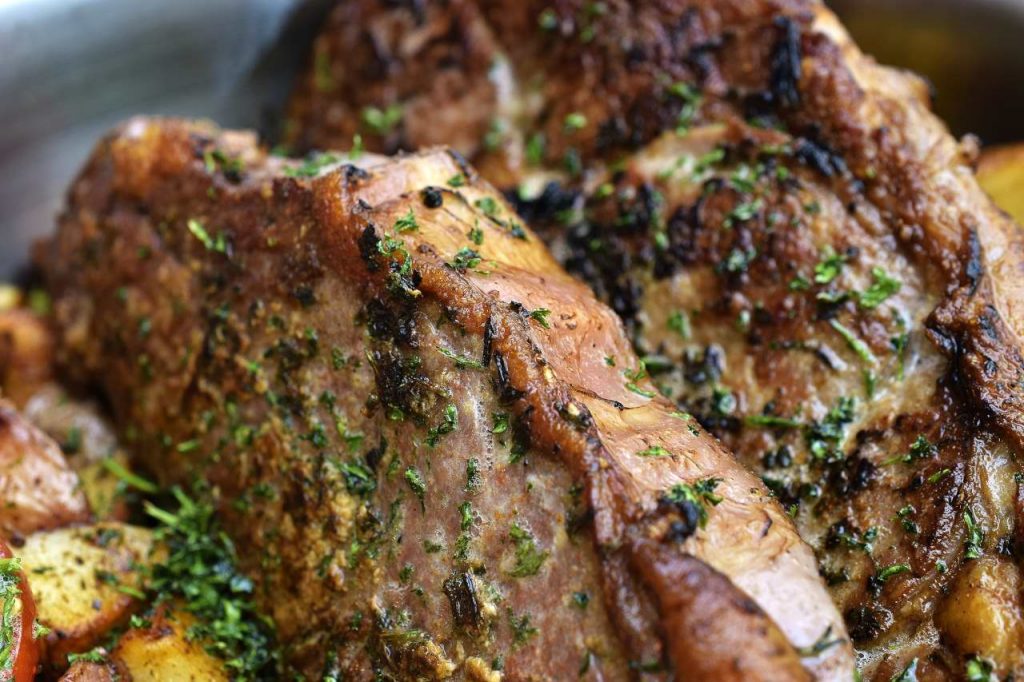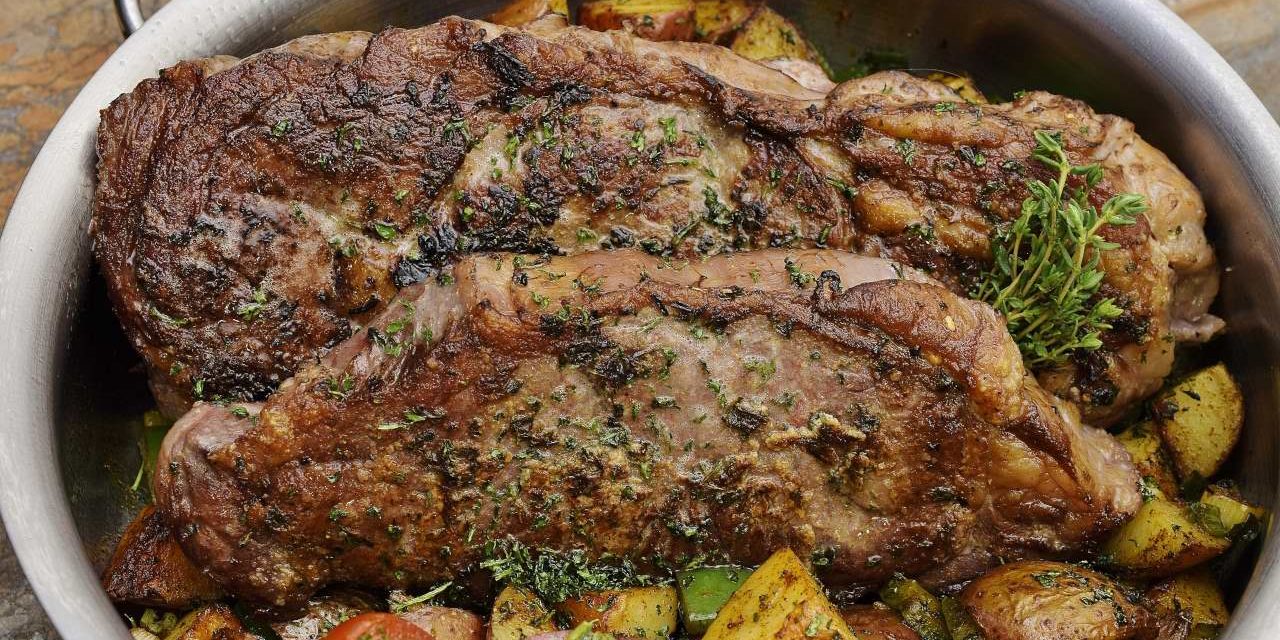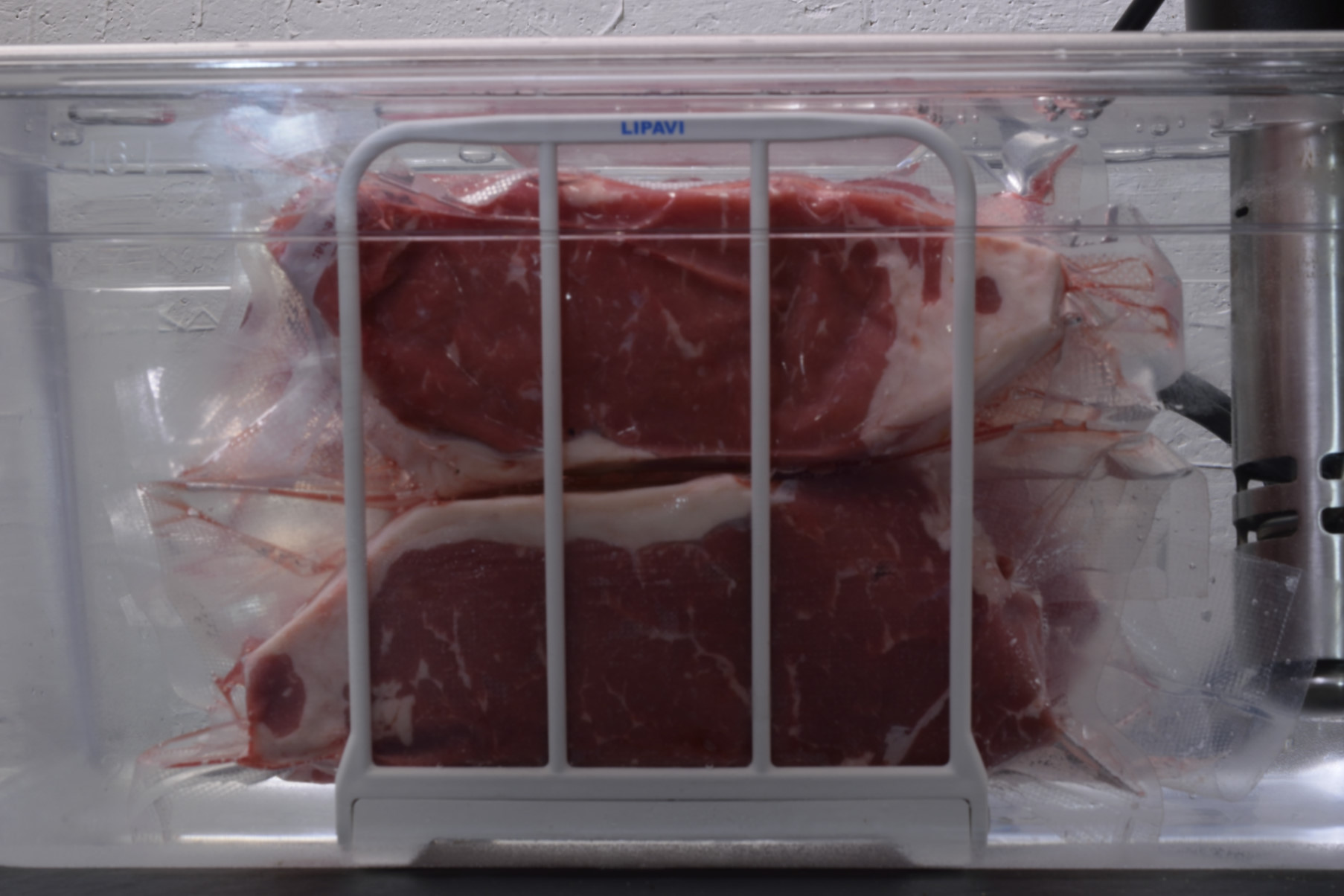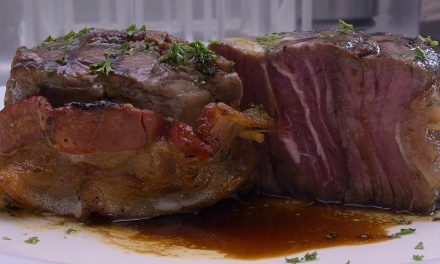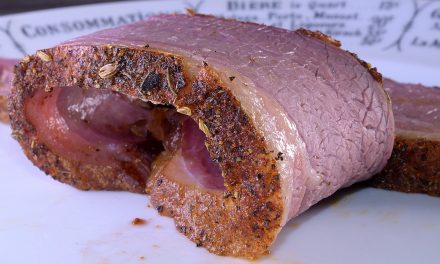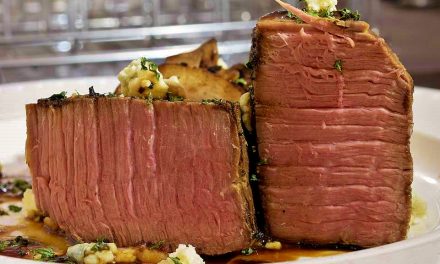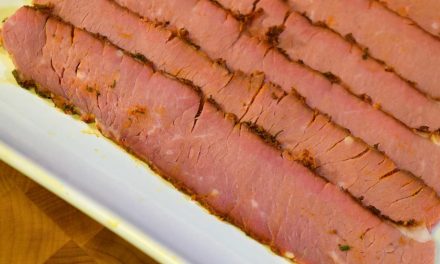What difference does it make?
Meat’s tenderness depends on how much strain is put on that particular muscle during an animal’s lifetime. Steers’ shanks, tongues, and cheeks get the most work, and they are very tough. Shoulder and chest muscles carry the most weight, also very tough. On the other end of the spectrum, the tenderloin gets almost no work at all. Its only real function is to protect the kidneys from impact. There is so little collagen in the tenderloin that if you do not handle it carefully, the narrowest end will actually start to pull apart.
There’s tender, and then there’s TENDER
The longissimus muscle runs along the spine from the shoulder to the hip. That’s one long muscle. Humans have longissimus muscles too. They run down our backs on both sides of the backbone. Humans stand on their hind legs, so those muscles get lots of work. They are very strong and would be very tough. We’ll just have to use our imaginations. The longissimus muscle on a steer can be as long as five feet. It is from the front half of this muscle that we get rib eye steaks. If the ribs are left attached, you get “prime rib.” From the hind half, we get what most of us call the New York steak. Some people call it a strip steak, strip loin, Kansas City steak, club steak or shell steak. For some reason, they don’t usually call it a New York steak in New York. Maybe they are just humble. I worked for a Swiss chef in my younger days who just referred to New Yorks as “steaks.” Everything else had a name–filet, rib eye, top sirloin, whatever. For him, “steak” was specific to the strip loin, and could only mean that one thing. If you told him “I enjoy a good steak” he would say “you should try a rib eye instead.”
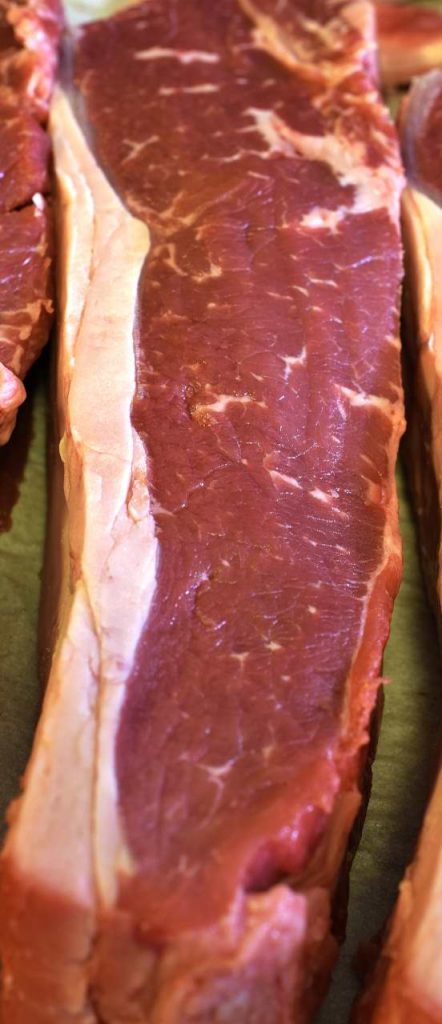
Rant, part I
I avoid buying individual steaks at the market. I buy whole strip loins, rib eyes, or tenderloins. Just doing that saves some money. If the cuts are still sealed in the original cryovac packaging, it is unlikely that they have been tampered with. When I say “tampered with,” I mean needled–injected. This is routinely done to individually cut steaks even in the “fancier” markets.
Below: rib eye, 132 F/55 C x 4 hours.
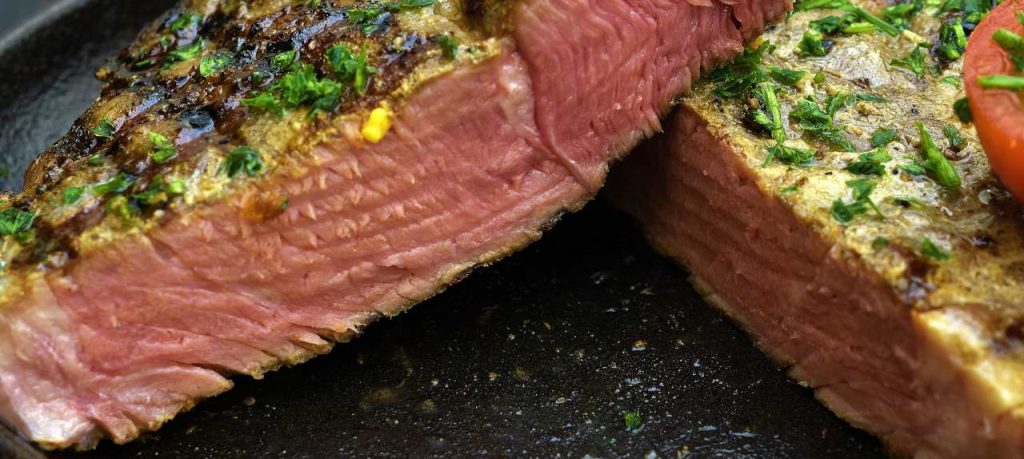
The justification is that injecting a saline solution makes the steak more juicy. This is not true. It temporarily makes the steak more HEAVY, and meat is sold by the pound, right? The solution that they inject drains out through the hole that was created during injection. This is not like getting a shot in your arm. The wound does not heal. There is no blood to circulate in a dead animal. The law specifies that all blood must be removed from the animal. If the blood was NOT removed at slaughter, the meat would go bad almost immediately. As a result, the injected juices just sit there until the temperature increases. Then they drain out. I admit, this bugs me. Sometimes you can even see the needle marks. By the way, the red watery substance that you see in packaging is myoglobin dissolved in water, not blood. Myoglobin is an oxygen transporting protein that occurs in the meat, not in the blood vessels.
Below: New York, 129 F/54 C x 4 hours
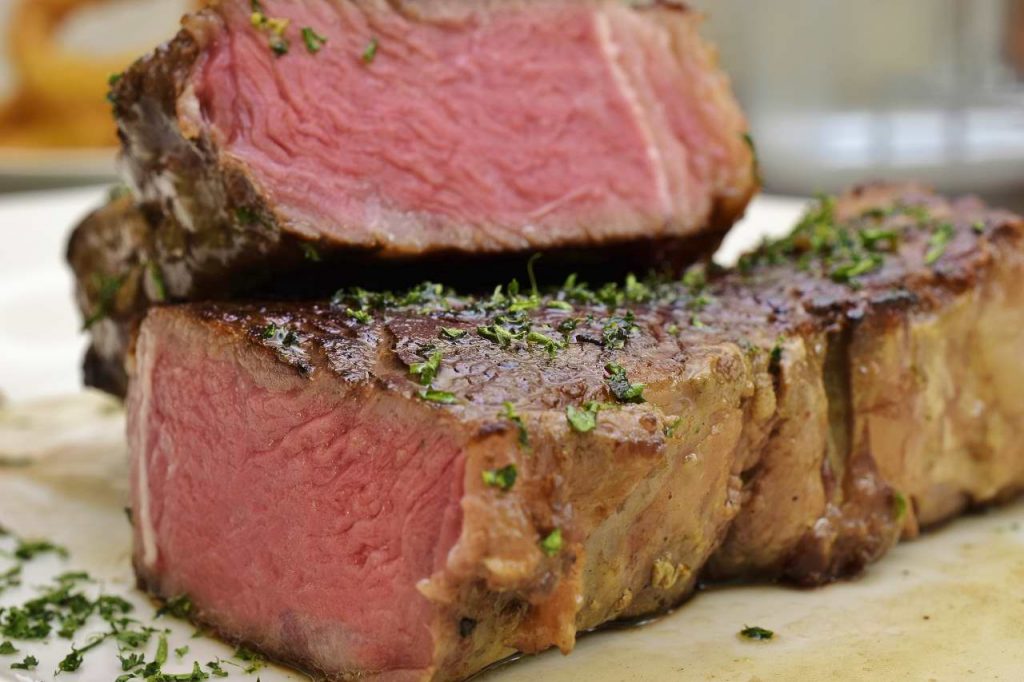
Inspection and Grading
Beef inspection and grading is just as widely misunderstood as butcher jargon and market packaging. ALL retail and wholesale meat MUST pass inspection by a USDA facility–it is all of equal safety and wholesomeness. Only beef is graded–there is no such thing as prime pork or choice chicken. Beef has eight quality grades: Prime, Choice, Select, Standard, Commercial, Utility, Cutter & Canner. Retail shoppers usually encounter only the first three grades. For the most part, the grades are based on degree of intramuscular fat (marbling) and the estimated age of the animal at slaughter. Conformation (shape) is also taken into consideration. The first two criteria can affect overall tenderness, but extensive marbling in itself does not guarantee tenderness. “Angus” is not an indication of quality or grade. Angus is a species of cattle. More on that later.
Never more than 6%
Marbling is not a direct indicator of tenderness, as I mentioned. Collagen levels are never higher than 6% of weight, but collagen alone dictates whether or not a cut of meat is tender. Collagen levels are hinted at by degree of marbling, but the relationship is not exclusive. Feed affects degree of marbling, but does not directly affect collagen levels. Species’ characteristics can have a major effect on marbling AND collagen levels. Kobe beef is an example of species driven marbling and collagen levels. Among prime, choice, and select, I have been unable to find any difference in the processing time and temperature required to achieve tenderization of tough cuts of meat. Prime beef short ribs and brisket may be highly marbled, but they still require extensive sous vide processing in order to become tender. Processed properly, I have never had a New York or rib eye steak that was tough, whether it was Prime, Choice, or Select.
Below: New York, 129 F/54 C x 4 hours.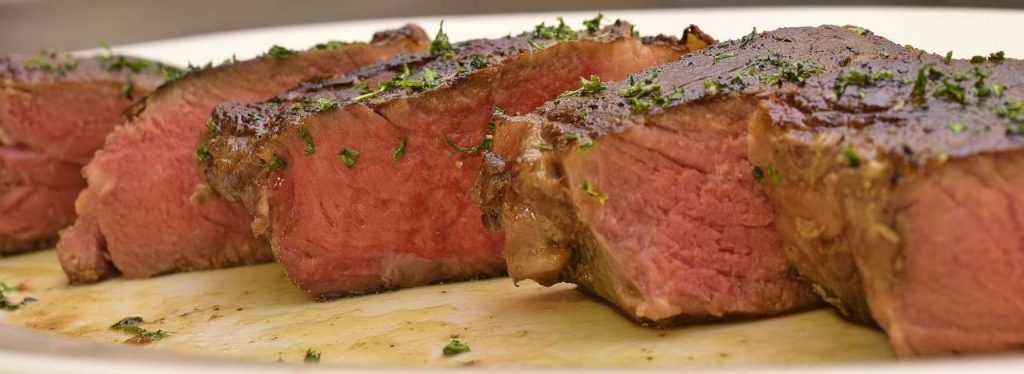
What does that have to do with anything?
No matter which cooking process is utilized, it is moist heat over time that converts collagen to gelatin. Marinades do not tenderize meat. Marinades cannot penetrate the surface of meat, with the exception of the salt that they may contain. People will tell you that salt breaks down protein chains and tenderizes meat, but it does not. If it did, corned beef would cook faster than brisket, and it does not. If marinades are acidic, they may DISSOLVE the meat from the outside in, but this is not the same as tenderization and does not affect collagen levels. Rib eyes and New York steaks require little or no tenderization because they have very little collagen. At sous vide temperatures around 129 F/54 C, collagen conversion occurs, but very very slowly. The sous vide environment removes less moisture and causes less cellular damage than other methods of cooking. Sous vide processing minimizes the perceptible difference between prime, choice and select. A Kobe New York steak benefits from sous vide processing because of the ultimate uniformity in appearance of doneness. Beyond that, other than by shape/conformation, it is extremely difficult to tell the difference between a properly sv processed prime, choice or select rib eye. Conformation itself does not affect tenderness or flavor.
Time, temperature and texture
How do you like your steak?
There is debate as to the exact definition of “rare,” “medium rare,” “à point,” etc. A little practice will help you learn just exactly what temperature corresponds to your preferred appearance of doneness. Here are some basic temperature setting guidelines:
Rare: 129 F/54 C.
Medium rare: 135 F/57 C
Medium: 140 F/60 C.
Medium well: 150 F/66 C.
Well done: 165 F/74 C.
Note: THERE IS NO SHAME IN WELL DONE.
Most of the world’s population does not even have access to the abundance of protein that we take for granted in the Western world. You can be sure that not a single one of them would shove a steak back at you and say “oh, my, that’s too well done,” or even “that’s too bloody for me.” We should be counting our blessings rather than looking down at our noses at people who don’t like their beef the same exact COLOR that we do. There is no accounting for preference, nor should there be.
And by the way, if you want to put ketchup on your steak, you go right ahead and don’t let anybody tell you not to. It is none of their business. We all need to celebrate our shared characteristics, and pay a little less attention to our differences.
End of rant, part II.
Below: rib eye, 129 F/54 C x 4 hours.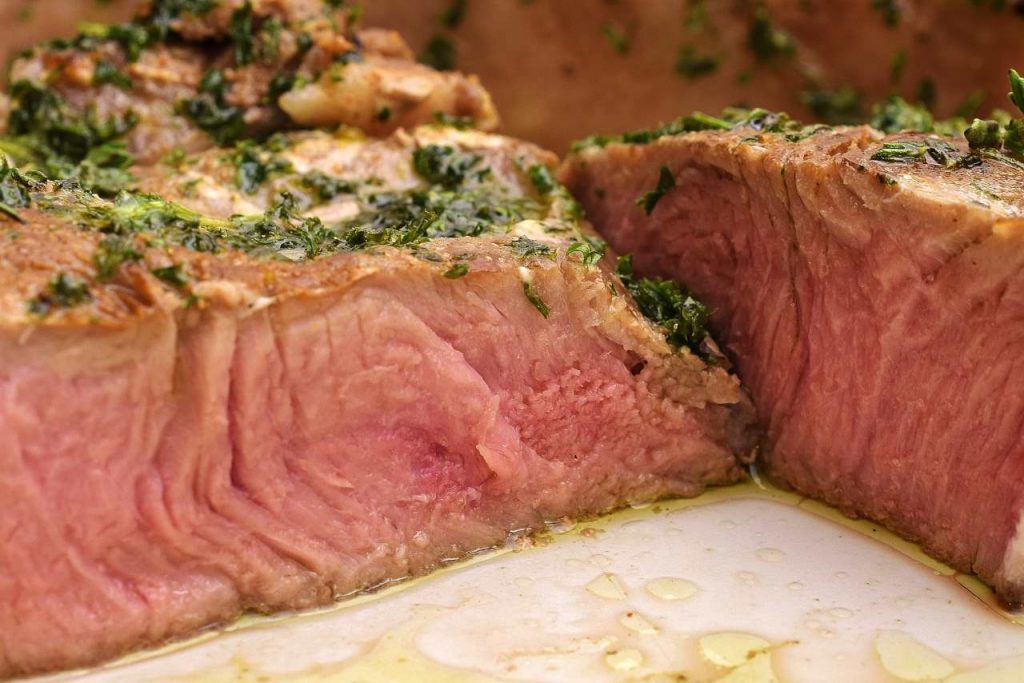
Back up the truck for a minute
A lot of people are intimidated by whole primal cuts because they are not confident in their ability to perform the necessary trimming. I am here to tell you than in the case of rib eyes, New Yorks, and even tenderloins, there is very little to it. You need a sharp, pointed knife with a narrow blade. Not a whole set. One knife. In the case of rib eyes, I do not trim them at all when I cut the steaks. Sometimes there is a little excess fat on the tail piece that is plainly visible and easy to trim before or even after cooking. If desired, you can shave the surface of the rib eye to remove the white, but it’s really not necessary. You can bet that hotels that cook fifty prime ribs a day do not bother with shaving the surface. It will not be detectable after cooking. Meat wasted.
Okay, maybe a little bit
In the case of a New York, a little trimming is required. And I mean “a little.” There is a tough strip of cartilage where the strip loin departs from the spine. It’s easy to tell how much to take off, because it is plainly visible and quite thick. It is really tough, raw or cooked. Use that sharp skinny knife to remove it in one or two strips; if some remains, you will notice it when you cut steaks, and you can trim it back then.
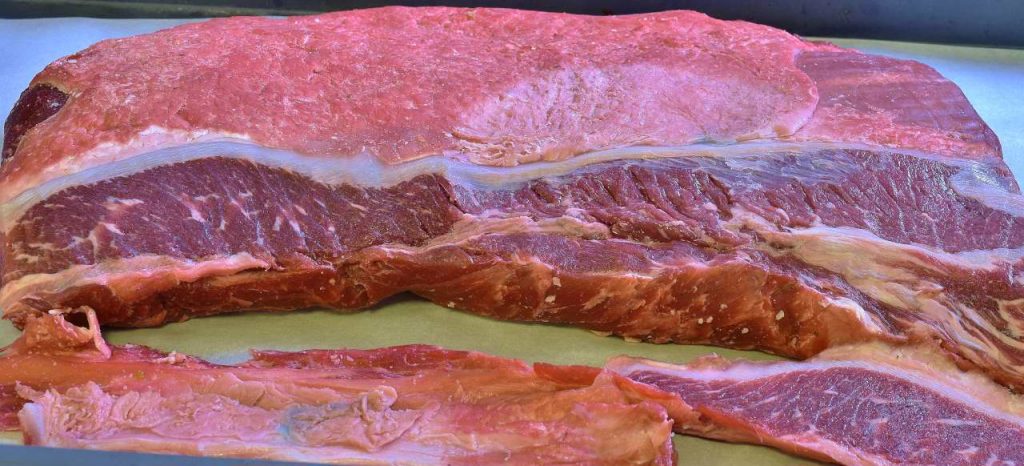
That’s all there is to it. Here’s another one we did a while back, after each end had been removed.
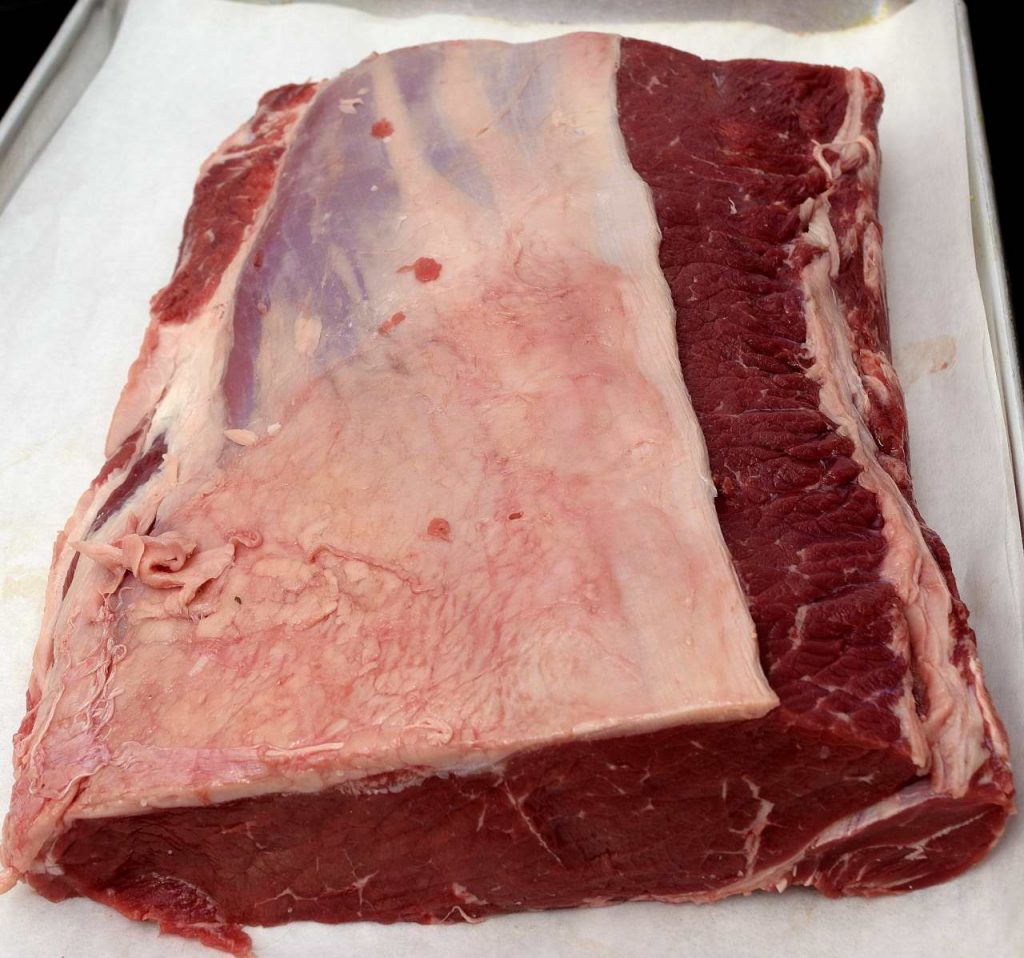
There is still some fat on the surface to be removed, but it’s easier to trim it as you cut the steaks. Some chefs don’t even bother.
Easier than boiling water
Set the sous vide bath to the temperature that most closely matches your preference. Stage each steak into a its own vacuum bag. Seal and sous vide process at that temperature for a minimum of two hours. As this article proceeds, we will point out rib eye and New York steaks that are somewhat “less tender.” If you are processing one of these steaks, that processing time can be extended to as long as eight hours to modify texture. That’s right, I said EIGHT HOURS. As I mentioned before, the lower range of temperatures convert collagen to gelatin extremely slowly. Don’t stand there and stare, waiting for your steak to achieve some imaginary appearance of tenderness. Use the pinch and poke method linked HERE to precisely determine texture.
As per your convenience, steaks can stay in the bath for at least two additional hours without risking any detectable difference in texture, quality or safety. Because of the precise characteristics of sous vide, and if service is delayed for one reason or another, steaks can stay in the bath up to eight hours. I have gone even longer, and as far as I can tell, the “mushy steak” syndrome is a myth. It seems that most of the people who claim that sous vide steaks are mushy have never actually used the process. Our rejections frequently precede our research. There is no “moment” before which the cut is tough or under-cooked, or after which the cut falls apart. Eventually, the pink color of a rare steak will dissipate if it is left in the bath for an extended period of time–long before it gets mushy, though. If you want to process several steaks to different degrees of apparent doneness, visit HERE.
Note: For enthusiasts who like their steaks extremely rare, they can be processed at temperatures as low as 122F /50 C. In this case the processing time should be limited to two hours in order to meet USDA food safety standards. The steaks should then be seared and consumed within two hours, just as one would if sous vide were not being utilized.
Once you remove your steaks from the bath, let them rest at room temperature for up to 15 minutes. Relax. This allows the surface to cool somewhat. Doing so prevents the searing process from elevating the internal temperature beyond the original target temperature. Then, you can season, sear and serve.
Now what?
Muscles are not uniform in texture through and through. Different regions of the same muscle can vary in tenderness. Wait. Woot? Well, most people never think about it, but it makes sense.

In the picture above, we have realigned the whole longissimus muscle for reference. At the far left end is where the rib eye connects to the chuck/shoulder of the animal. At the far right is where the New York connects to the rear end of the animal, actually, the top sirloin. In the background is where the muscle connects to the spine. In the foreground is where the muscle connects to the brisket and the belly.
Below, we see the intersection of the rib eye with the New York, comprised almost entirely of longissimus muscle.
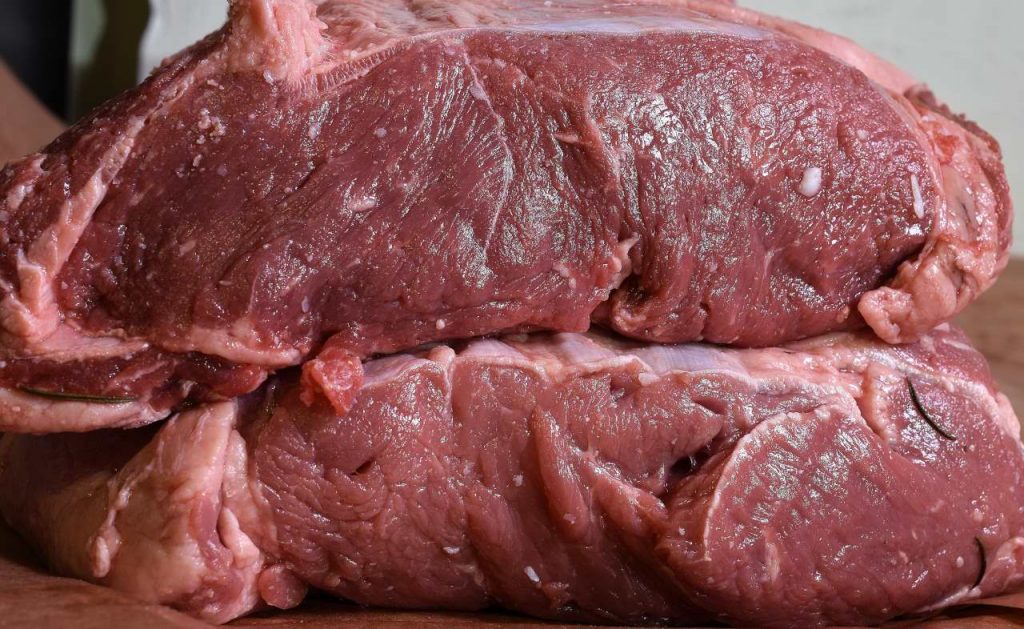
Which is which? Well, it doesn’t matter. The decision to split the muscle at this point is a matter of convenience and convention. There is no difference between the last cut of the rib eye steak and the first cut of the New York steak. The rib eye is actually on the top in the picture above. As I explained, this is from about half way down the spine. It looks very lean and uniform.
Below: the rib eye end of the New York, skin side down.
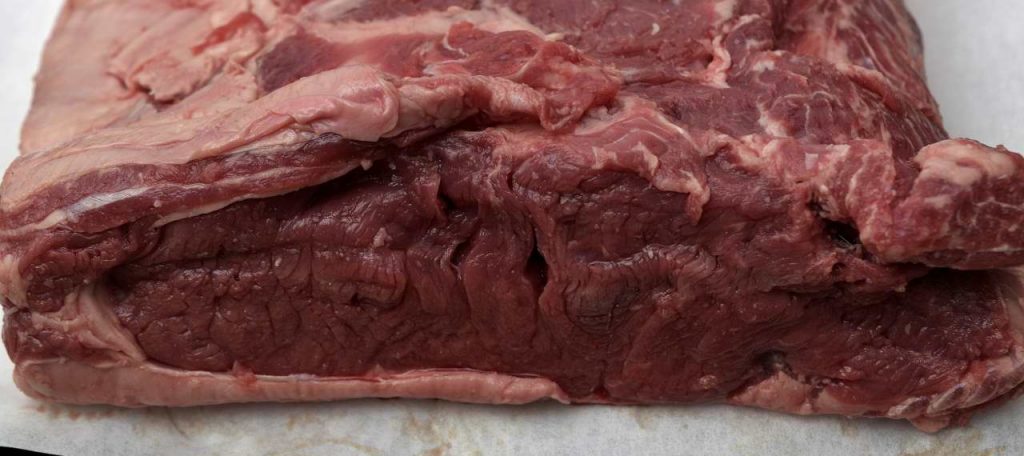
There’s only one problem. As little work as the longissimus muscle gets, it still stands to reason that this section–half way down the back–gets a little MORE work than the rest of the muscle. It carries the most weight, rather like the center of a hammock.
This can create a certain amount of disappointment for enthusiasts who select steaks purely on the basis of that lean, uniform appearance. People frequently complain about the steaks cut here and near this intersection. When people say “rib eyes (or New Yorks) are always tough and dry,” it is usually because they have inadvertently and repeatedly chosen these particular sections without knowing that it makes a difference.
Go to the front of the line
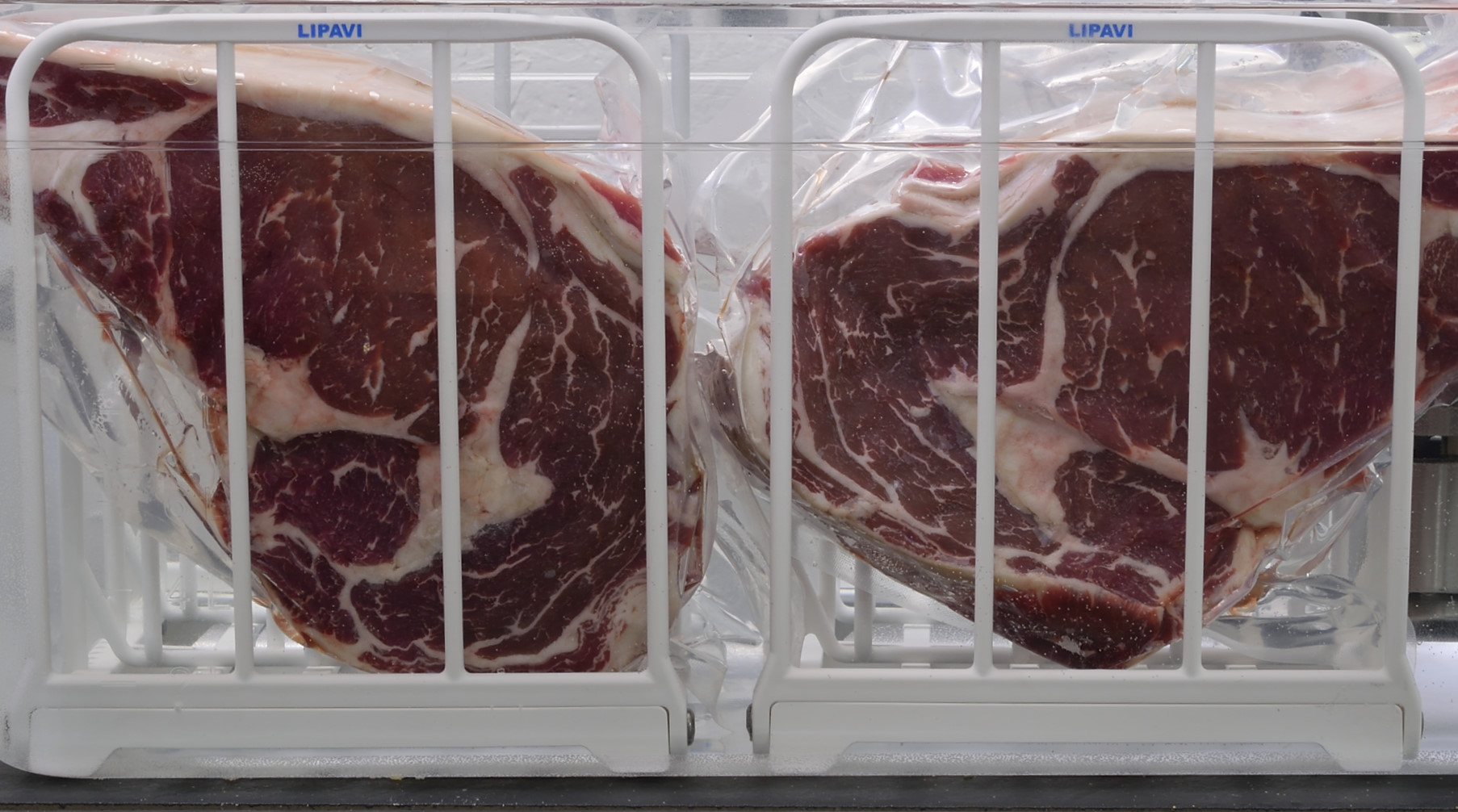
The longissimus muscle doesn’t get much work–we have established that. Seen below, the end of the rib eye that connects to the shoulder is actually several muscles, of which the longissimus is the smallest one.
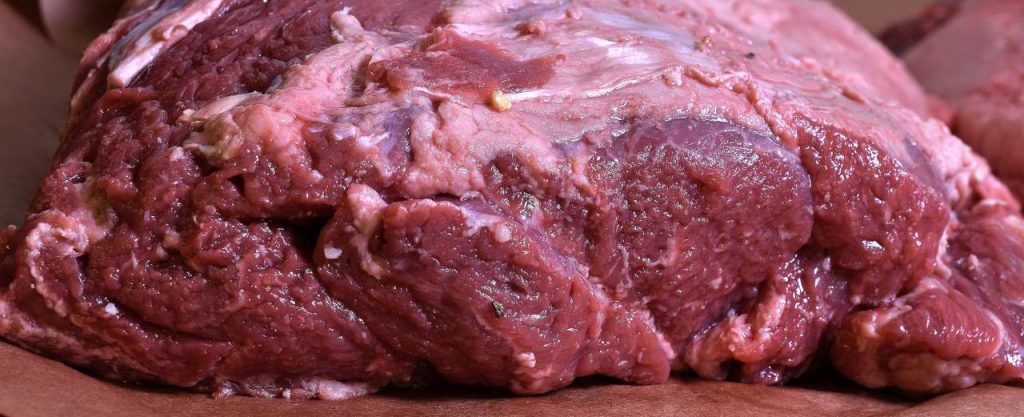
The curved muscle on the left hand side of the picture is called the spinalis dorsi muscle. It is also called the rib eye cap. It is very tender. To the right of the rib eye cap is a cross section of the longissimus muscle that amounts to about one third of the area of the picture. There are several small muscles to the far right, usually called the “tail.” These muscles connect to the ribs as they proceed towards the sternum. They also receive very little exercise.
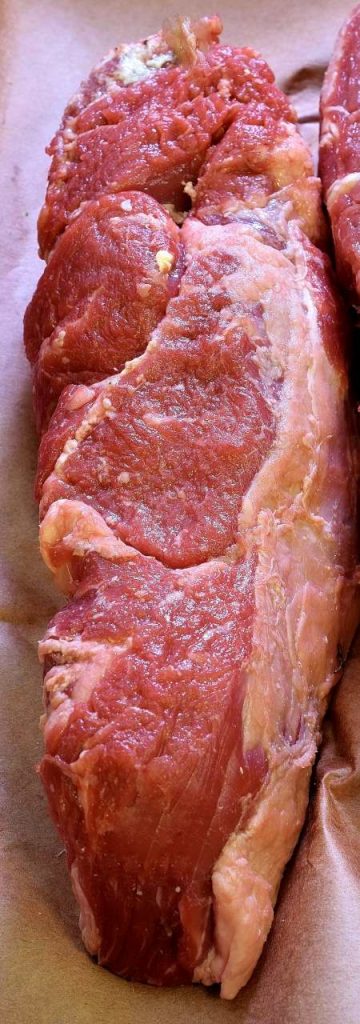
This end of the primal cut is clearly the least visually appealing of all the cuts. But that is deceptive. It is actually one of the tenderest sections of the entire primal cut. The very first cut has a slight tendency to separate at the seams during cooking. Sous vide processing moderates this by holding the meat still during processing.
The steak depicted below is the second cut from the shoulder end of the rib eye. 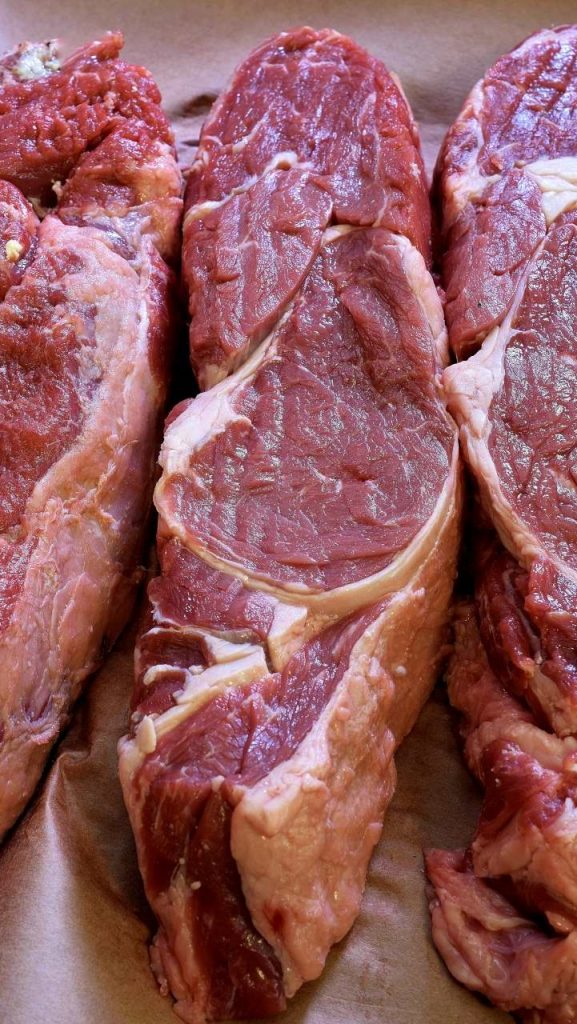
You can see how dominant the “cap” muscle that we discussed is–almost a third of the whole steak. For me, this is the most desirable steak from the entire muscle, be it rib eye OR New York. It is from this general area that the so called “Delmonico” steak was originally cut, although you see that name applied to all kinds of different steaks these days. The labeling of meat in the butcher’s case has a lot more to do with marketing than it does with anatomy, but no butcher will ever tell you that. Cooked, this rib eye looks something like this:
Below: rib eye, 132 F/55 C x 3 hours.
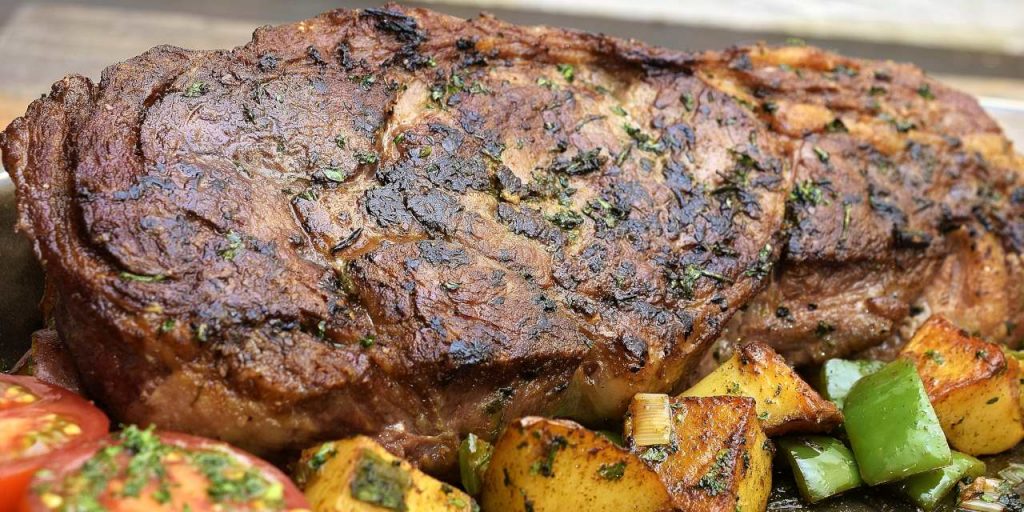
Occasionally, butchers will remove the spinalus dorsi muscle from the rib eye, roll it into a pinwheel and slice it into steaks. Also very visually appealing. Keep in mind that it will unroll when you cook it unless you or the butcher tie it with string. Even if you do so, it will unroll once you cook it and remove the string, so there’s that. I prefer to leave it attached to the rib eye. Still, the texture of the spinalus dorsi is unique and unctuous. Packaged as I described, you will see it being marketed at $16/lb or more. Better to buy the whole rib eye and make the decision yourself!

I cut eleven rib eye steaks to approximately 24 oz/675 g. That is a big steak, easily enough for two people. The alternative is to cut a very thin rib eye steak, which I do not recommend. This rib eye was large–about 15 lb/7 Kg. They can be even larger. Rib eye steaks with a smaller eye are available at a higher price. They are easier to cut thick without exceeding 16 oz/450 g. If you don’t mind changing the shape of the steak, there is such a thing as an “entrecôte mignon”–it comes from the rib eye, but is cut to resemble a filet. You cut it in half lengthwise and serve it something like this:
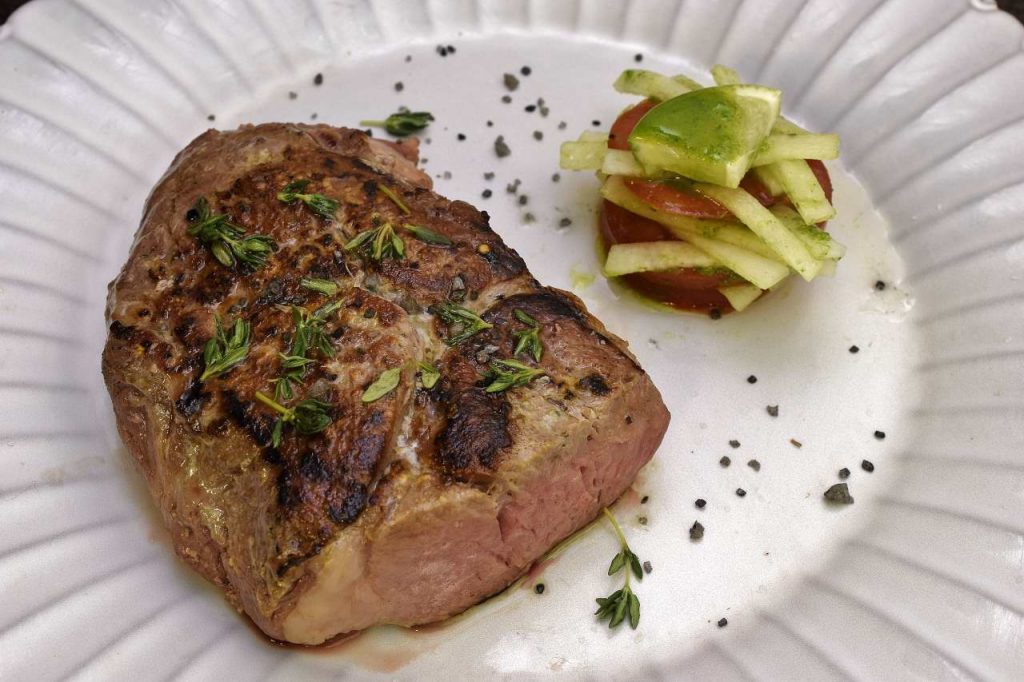
Above: entrecôte mignon, 132 F/55 C x 4 hours.
Slaughterhouses tend to isolate the smaller rib eyes to sell with the bone still attached. Sometimes a bone-in rib eye can cost more per lb than a boneless one. This is due to market forces and what they call “conformation,” the shape of the cuts removed from the carcass.
Bury the tomahawk
Some people think that the bone contributes flavor to the steak, but the scientific evidence strongly contradicts this. Bones are not porous, for one thing, and there is a membrane between the bone and the meat that is extremely high in collagen. Not very receptive to the exchange of flavonoids. Bones are also very heat resistant. By the time the steak is done, the marrow in the bone is still barely warm. Whoever popularized the so-called tomahawk steak has earned my cynical admiration. We have actually been convinced to pay steak prices for bone, just for bragging rights on the weekend.
Angus who?
Angus cattle are popular because of their conformation/shape. The hide is black, by the way. The hair might be, but need not be. Angus cattle are short, blocky, and smaller than most other breeds. This makes them easier to transport as well. They yield a very “short” New York steak, and a very tight, round rib eye or prime rib. An Angus “export rib” (bone-in prime rib) may weigh as little as 14 lbs/6 Kg. Some bone-in export ribs weigh as much as 26 lb/12 Kg. They can be of excellent quality but are difficult to fit on a plate, and therefore less desirable in most cases.
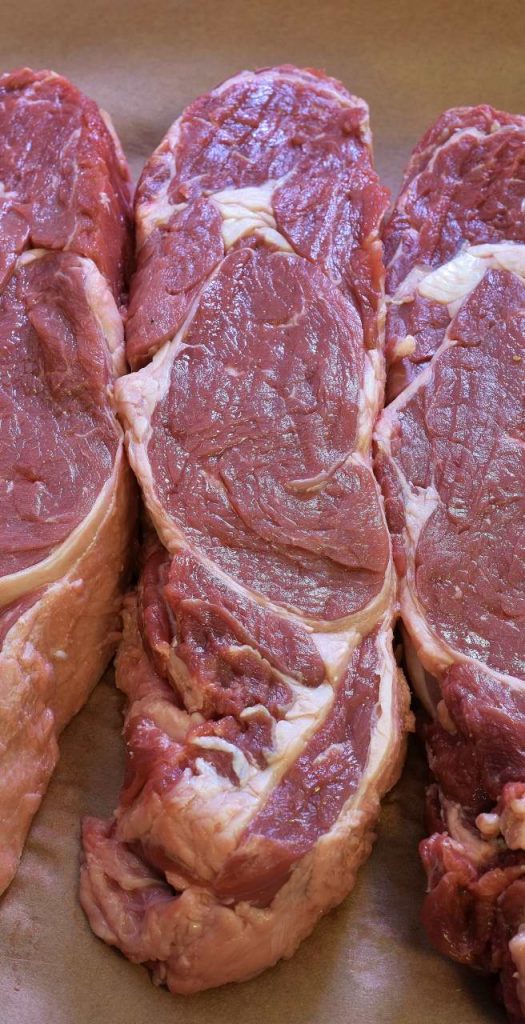
The steak above is the third steak from the shoulder end. Again, you can see that the spinalus is still very prominent.
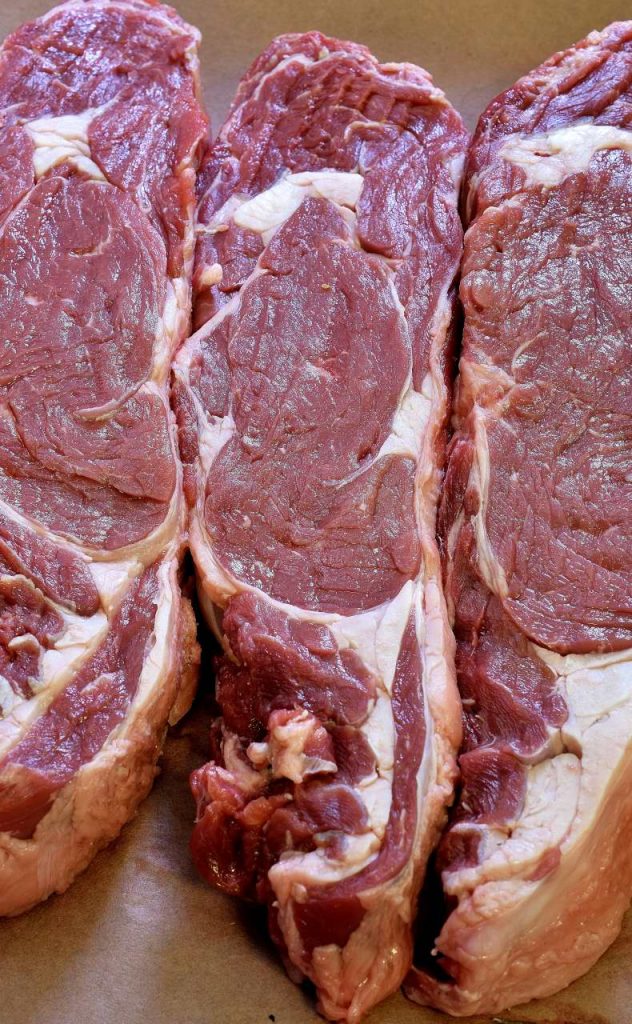
Above, the fourth steak from the shoulder end, almost half way through the rib eye by now.
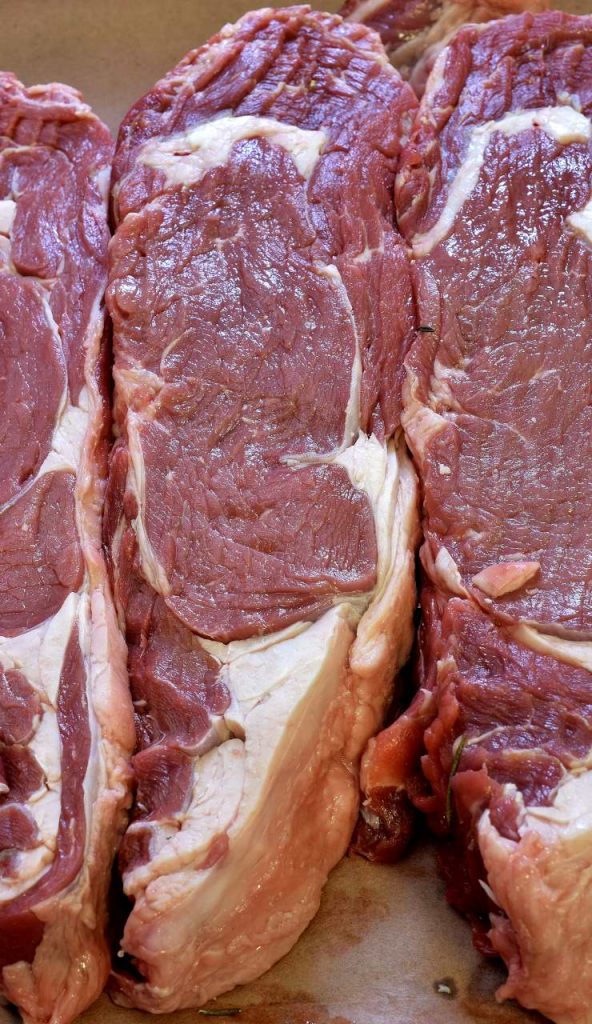
Above: the fifth steak from the shoulder end. Still plenty of spinalus. As the amount of fat on the tail increases, it can be trimmed. Or not.
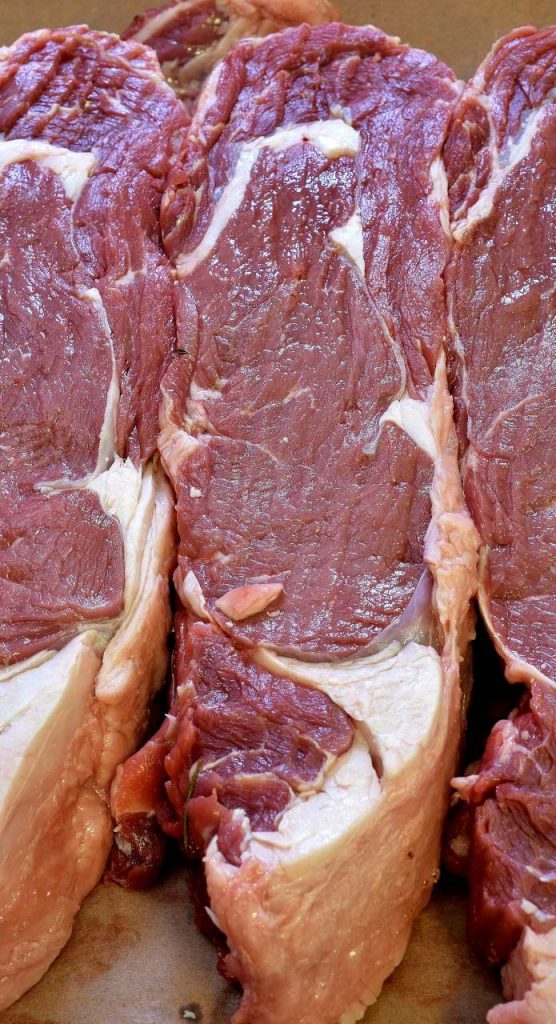
Above: this is the sixth steak from the shoulder end, and you can just see the spinalus starting to taper down.
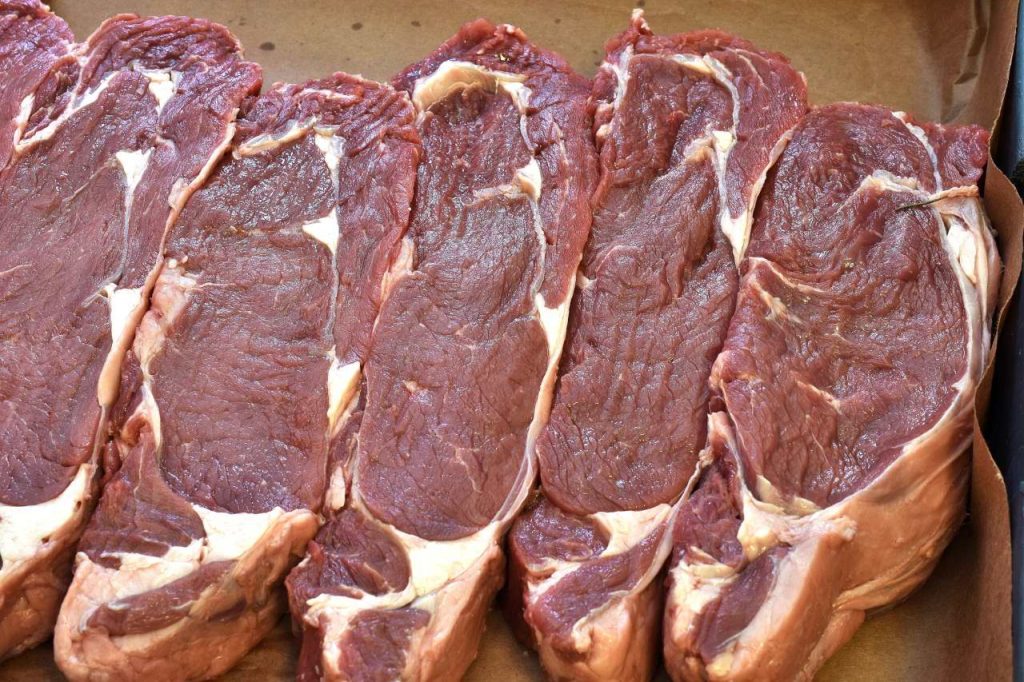
These are the last five rib eye steaks from a total of eleven, looking more and more like New Yorks. By the time you get to the last one on the right, there is really very little spinalus muscle visible. None of these steaks are “tough.” But this last one is the most heavily worked, the center of the hammock and the “least tender.”
A New York state of mind
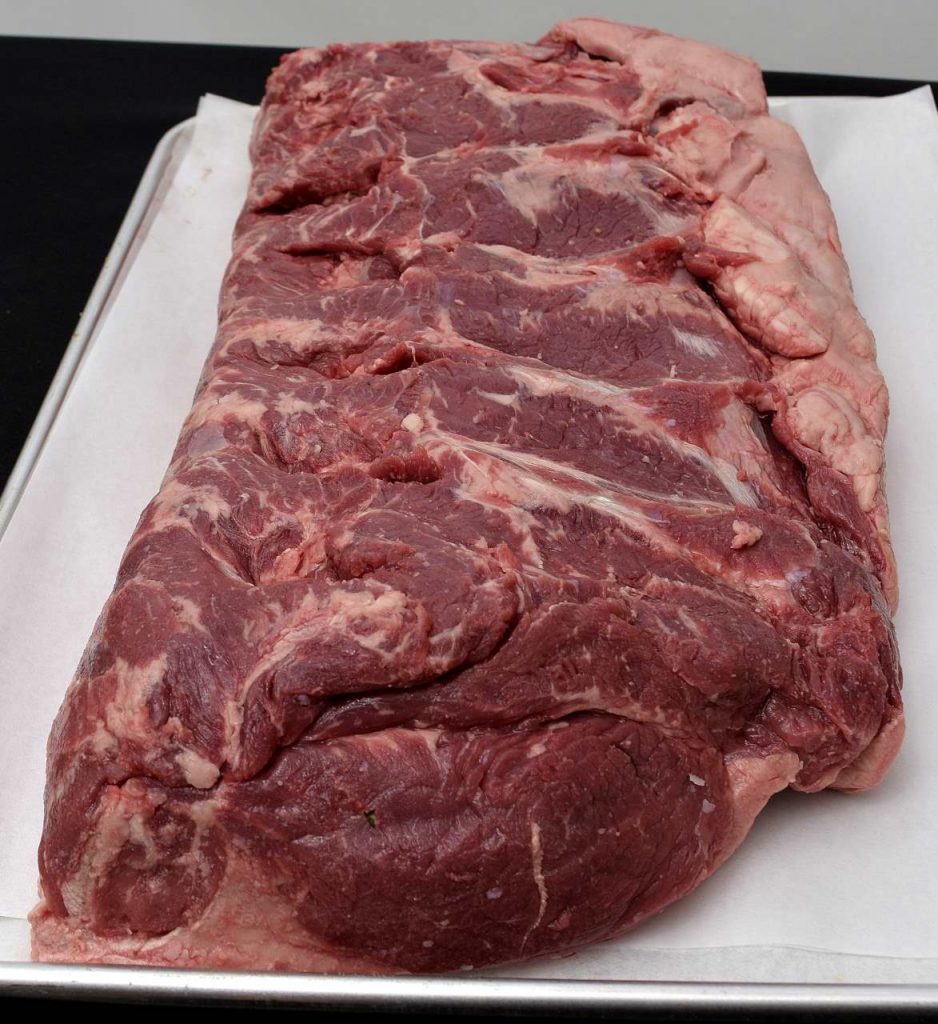
This is the hip end of the longissimus/New York, skin side down. It is also deceptive in appearance. At this end, the longissimus muscle has changed shape, flattening out and shrinking to form the top layer of the upside down strip loin. The oval shaped muscle below connects to the top sirloin, an article for another day. Both muscles are fairly tender, but they are separated by a layer of connective tissue that is quite tough. Here’s a picture of the same end, skin side UP.
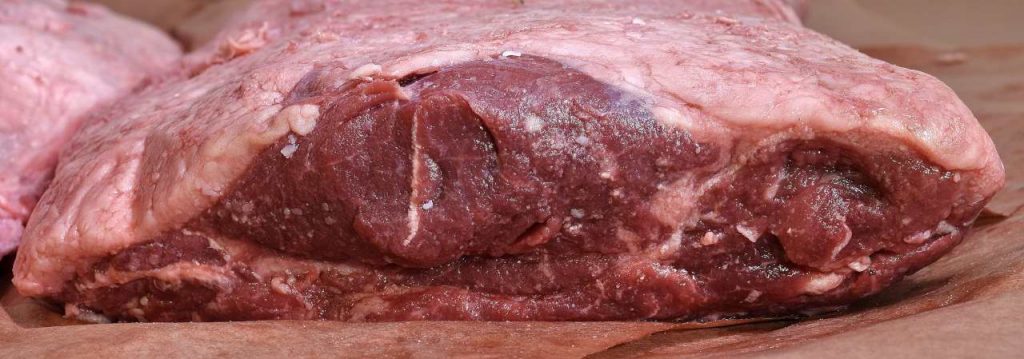
Below is a picture of that end, cut as if for a steak.
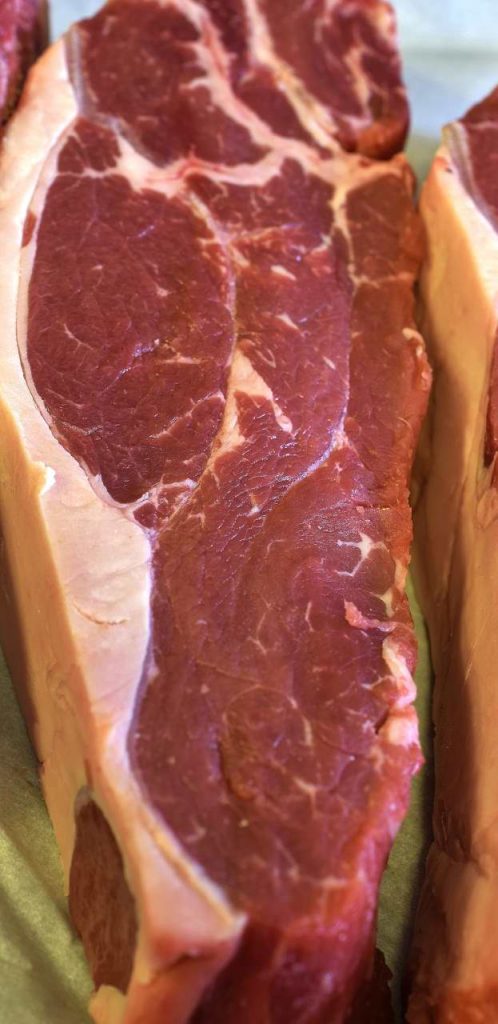
You can see the layer of gristle. Chefs call that the “nerve end” of the cut. I see these in the butcher case. They are usually priced just the same as better cuts of New York, a testimony to the casual deception perpetrated by marketing experts. Like I said–not all steaks are created equal. Not by a long shot. This is going to be one tough steak.
As this cut proceeds, the oval profile grows as the longissimus shrinks, and the New York morphs into what we call the top sirloin or top butt.
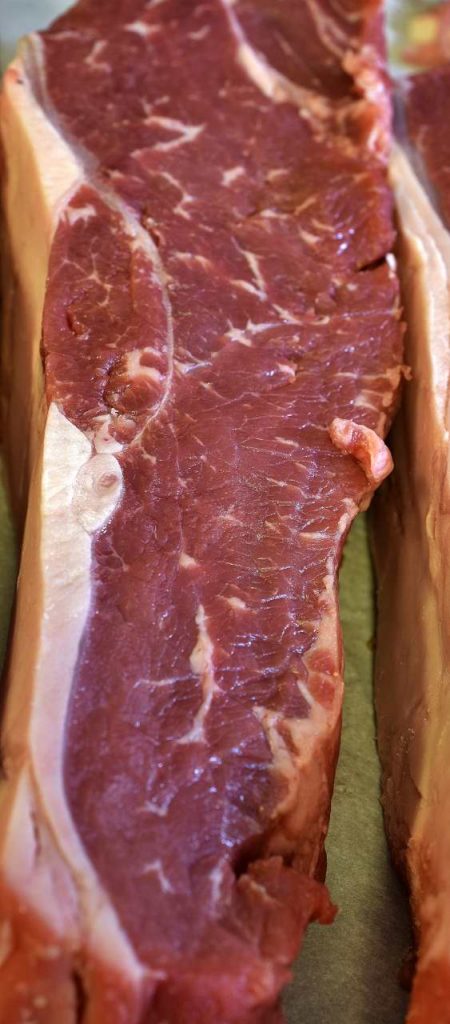
Cooked to medium rare or so, this steak is going to be very gristly. Butchers will flip them over to hide the gristly oval, so they must know what they are doing. They are maximizing the appearance of value, as they were trained to do. It’s a business, not a charity. Some chefs set these aside for people who order their steaks well done. Once the steak is cooked to that point, the connective tissue becomes a little bit more tender. Many chefs categorize people who order their steaks well done as preferring their meat somewhat chewy. Be that as it may, other chefs just remove the gristle and cut the meat for things like Beef Stroganoff, stir fry or brochettes, etc.
For my purposes, I grind it into hamburger, for which it is great. The cost of doing this is absorbed by the savings realized as a result of buying the whole strip loin–this one was under $7/lb. Compare that to the pre-cut, and possibly needled New York steaks in the butcher’s case. Prepare to be shocked.
Where the rubber hits the road
Okay, now we’re getting somewhere! The pictures below depict eleven New York steaks that I cut closer to 16 oz/450 g to achieve more or less the same thickness as the rib eyes. Restaurants usually cut their steaks to a certain weight because the price is pre-determined. But nobody wants a thin steak. That’s another great thing about buying whole primal cuts. You don’t have to pore through the butcher’s case to find the thickest steak. You just cut it. Or not. The strip loin makes a great roast, too.
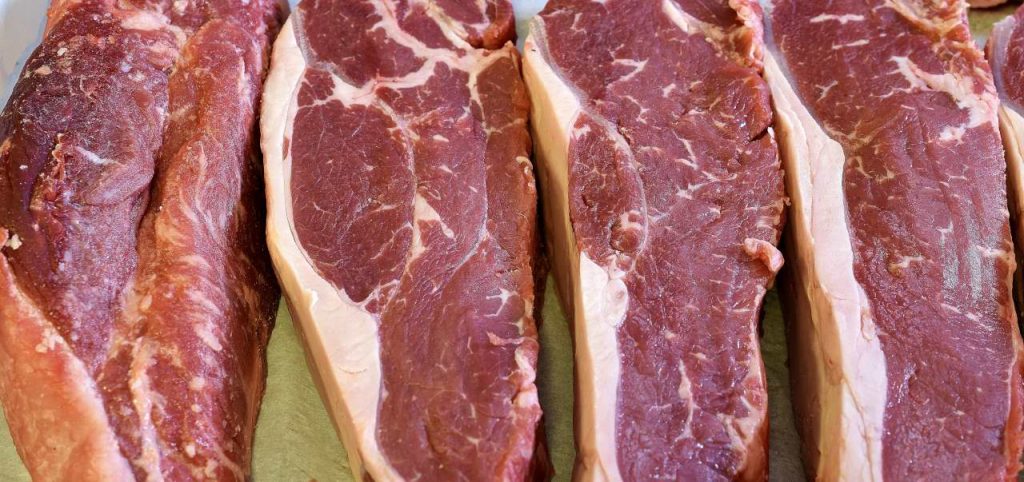
Above: from left to right, the tough, hip end and the next three. You can see the gristly oval shrinking as we move towards the front of the animal. The steak all the way to the right–the first one after the oval has completely disappeared. That is the one I save for me. 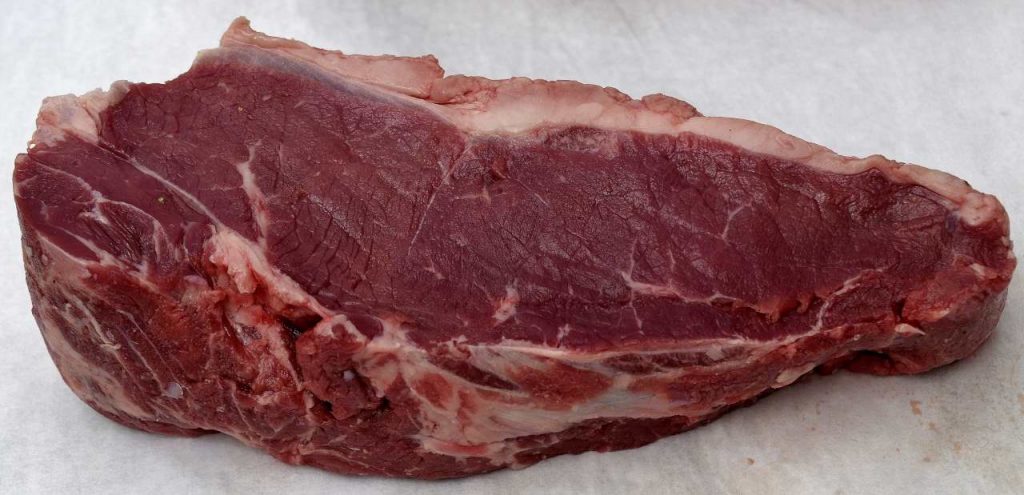 It has the best shape, the most marble and the best texture of all the New Yorks.
It has the best shape, the most marble and the best texture of all the New Yorks.
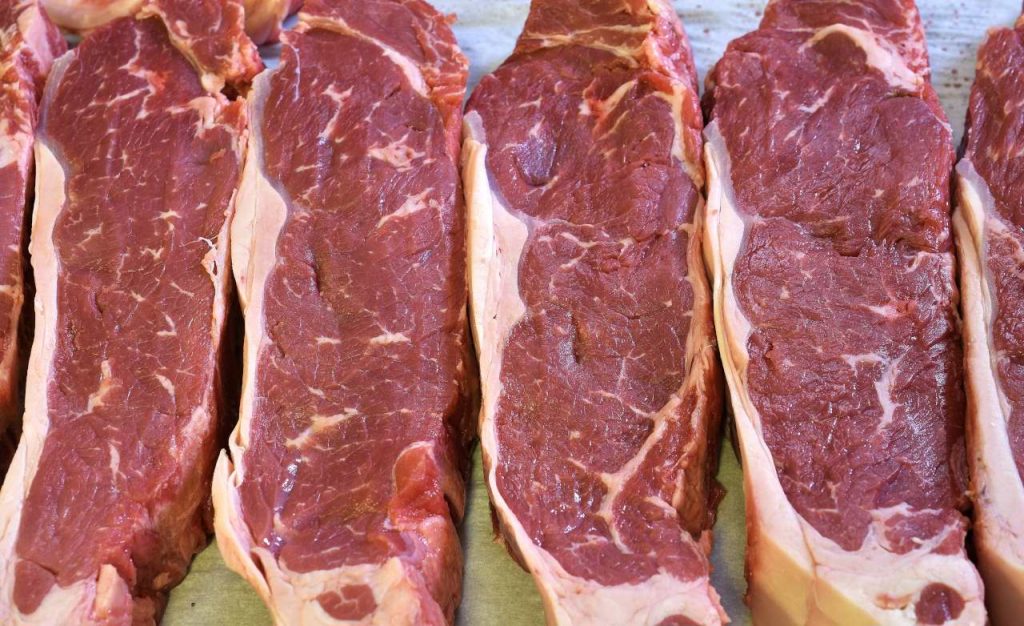
Above: the next four. These are among the most desirable of the New Yorks–narrow and long.
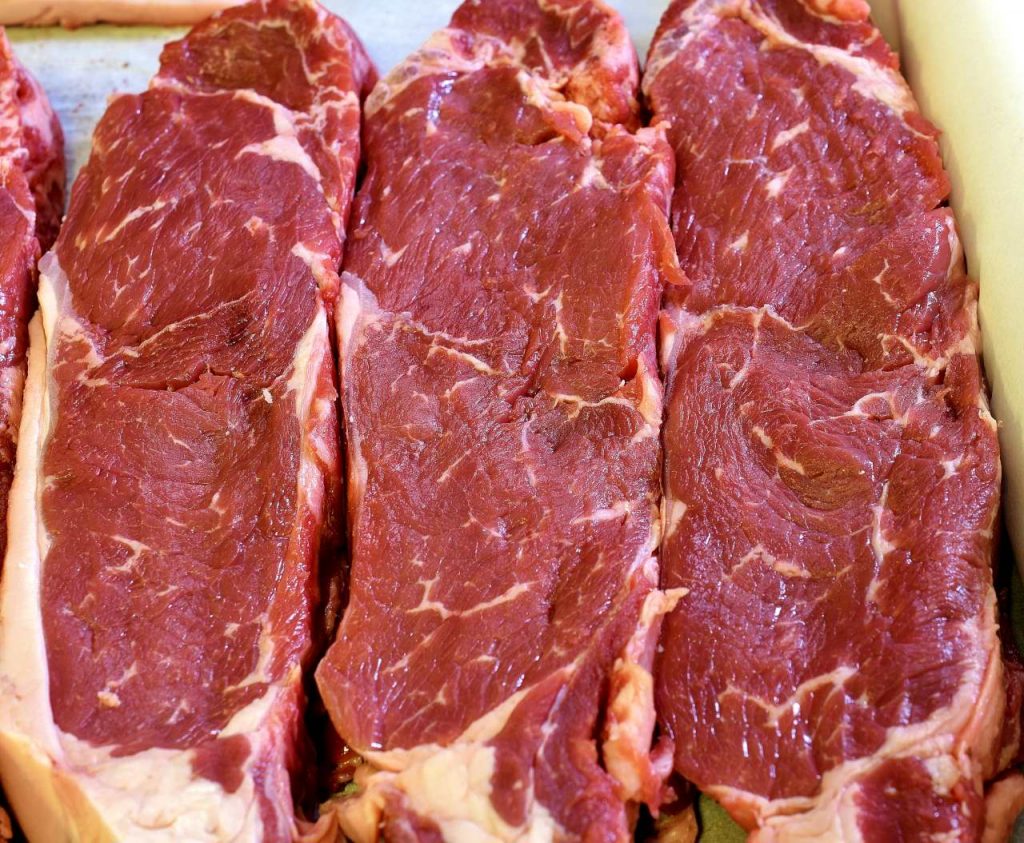
And these are the last three New Yorks. You can see that they are becoming more round in shape, and the last one on the right may as well be called a rib eye, just as the first cut from the rib eye may as well be called a New York. They are not tough. They may be “less tender” than some of the other cuts that I pointed out. We talked about that in the time/temperature section.
Presentation
When chefs use the word “presentation,” most people think of the extreme elaboration of foods to create altitude and a lot of splashy colors. Edible flowers and other labor intensive decorations seem pointless to the novice, and for good reason. Beyond eye appeal, they are unrelated to the quality of the ingredients. Chefs indulge their competitive spirits to create presentations so complex that the components themselves may become unrecognizable. Admittedly, there is a certain amount of one-up-man-ship involved. But there is more to presentation than that, or, rather less, now that I think about it.
When it comes to rib eye and New York steaks, a certain consideration of presentation matters because it affects the diner’s perception of tenderness. In this case, the salient point is which part of the steak is the diner going to dig into first?
Is it 7 o’clock yet?
So many years ago, I was trained to adhere to some very strict principles. Many of them have been abandoned as time has passed. Some of the disciplines that we apprentices were supposed to embrace were not designed to improve our skills or value, but more to discourage those of us who might be somewhat less committed to learning. A sort of “weeding out” process, with some mean spirited hazing thrown in.
One of the disciplines that fell by the wayside was the so called “7 o’clock rule.” This guideline is based on the premise that, among other things, most diners are right handed. This is true about 90% of the time. The guideline first asserts that when we descend on to a plated steak, our fork is in our left hand and our knife is in our right–the way silverware is typically placed around a table setting. The second assertion is that in our typically unconscious or even mindless fashion, our hand leads the fork towards a specific region on the plate–right about 7 o’clock. The fork goes in to the steak, the knife cuts the steak, the diner takes his first bite. If you watch diners in steak houses dig in to their entrees, you may be amazed to see this pattern acted out as if by law.
Assuming that all this is true, the chef certainly doesn’t want the diner to take his first bite from where even the smallest amount of gristle or fat might occur. Chefs don’t like to see people moving steaks around on the plate, either. That’s like taking a painting and turning it on its side to see if you like it better. The food on the plate should be inviting, not puzzling.
Below: New York, 129 F/54 C x 4 hours.
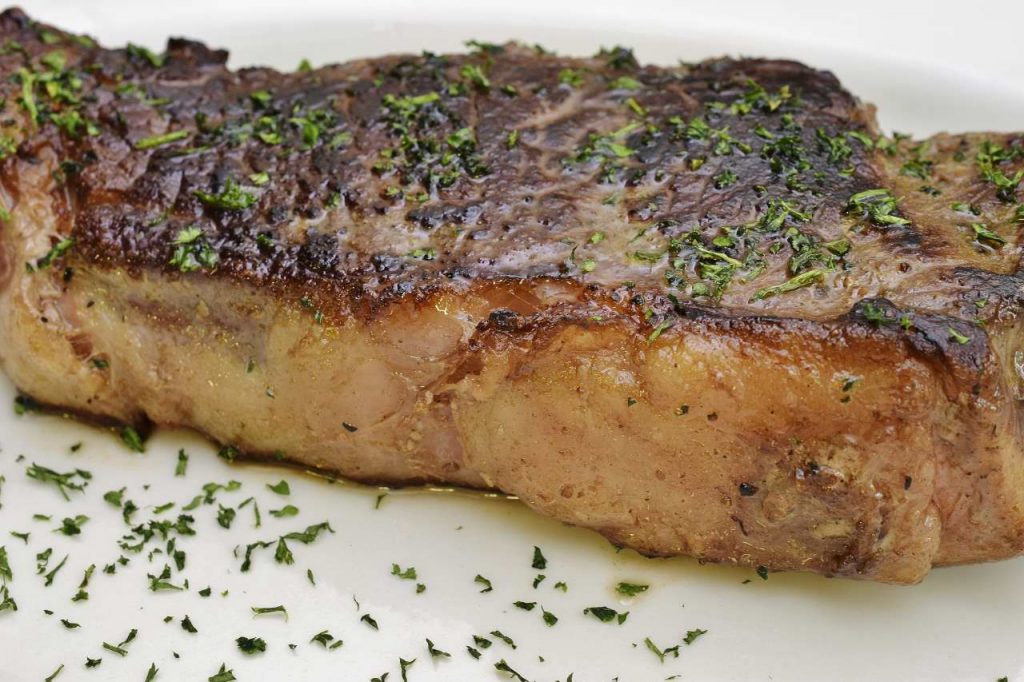
I offer this viewpoint of a New York steak to illustrate how a steak should NOT be served. There is a thin layer of fat and tender gristle that is typically left on the New York steak. If you have been following along so far, you have encountered it. It can be removed, but is almost always left on, if only to precisely confirm that the New York steak is what it says it is. See the picture below:
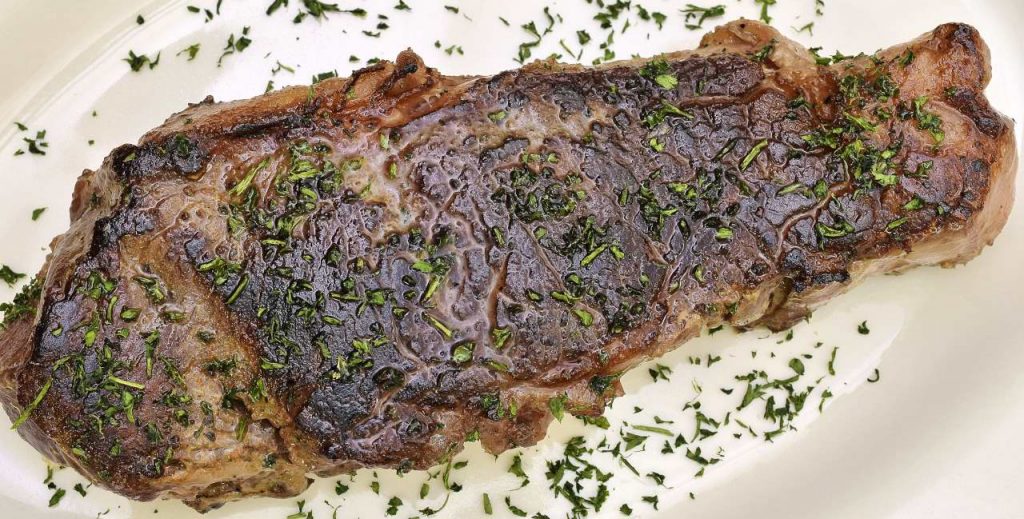
Above: New York, 129 F/54 C x 4 hours.
You can see that the layer of fat/gristle is now on the “away” side of the New York, so that’s good. But there is more. On the left side is where the steak originally connected to the spine. I will stipulate that in this picture it is closer to 8 o’clock. That is just about the tenderest spot on the steak. That is where the chef wants you to start your culinary journey. On the right side is a little “nugget” which is connective tissue leading towards the animal’s belly. Even though the nugget is moderately tender, it is rather fatty. Many steak lovers cherish this little treat at the end of the steak, which, again, is almost always left on for purposes of identification. No other steak looks like that, nor can any other piece of meat be cut to look like that.
The 7 o’clock rule also applies to the rib eye steak, as shown below:
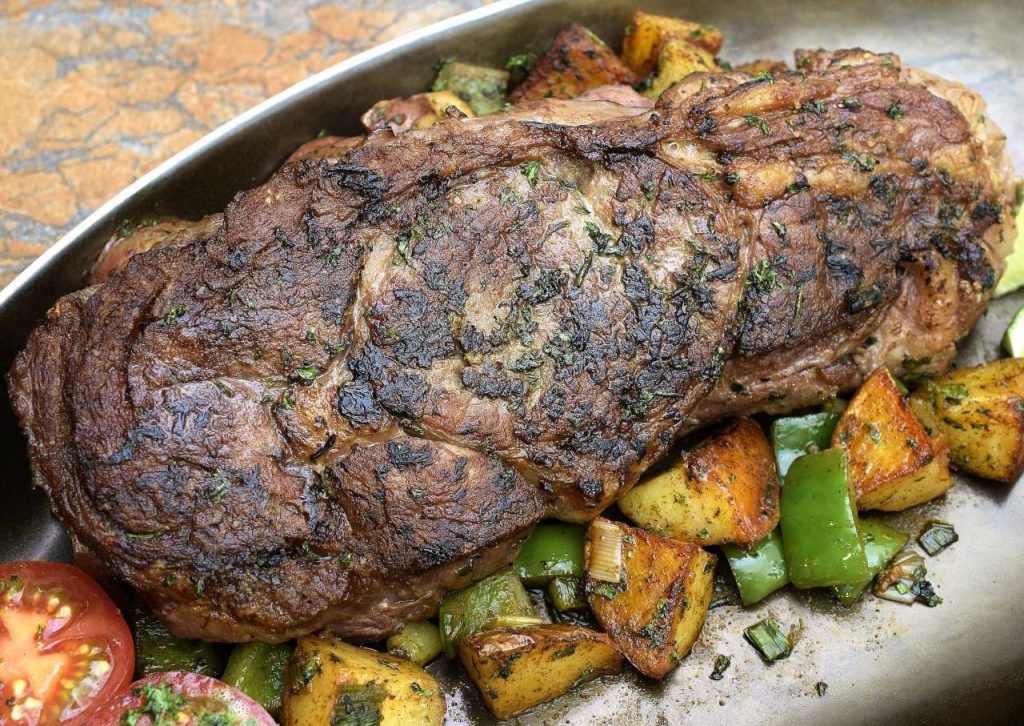
Above: rib eye, 132 F/55 C x 4 hours.
If the 7 o’clock rule is applied, the first bite will be taken from the spinalus dorsi muscle that we discussed earlier. In the top right of the frame, you can see the some what larger “nugget” of tail piece that connects to the bones leading to the sternum–fairly tender, but quite fatty.
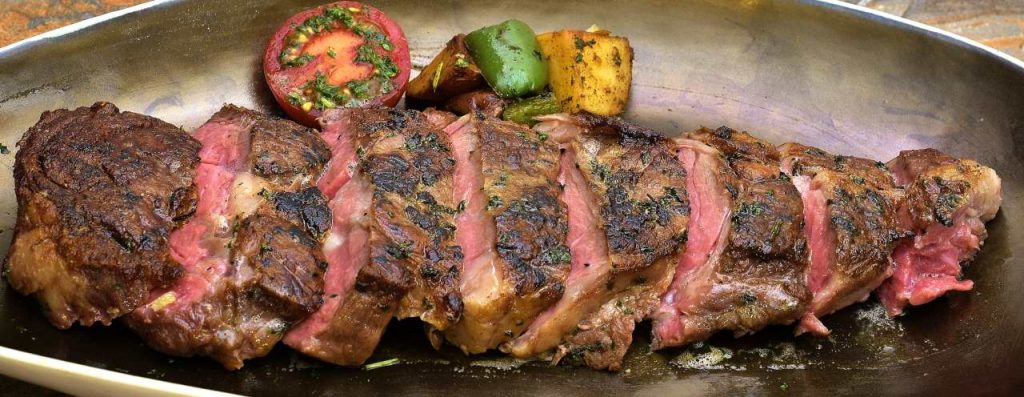
If you google “New York/rib eye steak presentations” and click on “images,” you will see that this rule is almost never followed photographically. Kind of sad, really, but of course, a photographer is not concerned with where you take your first bite, and he/she’s unlikely to let the chef offer any advice. I am only an amateur photographer, but I still shake my head when I see a steak that violates the 7 o’clock rule. I don’t need towering vegetables or fresh flowers on my plate with my steak. But I still want the steak to be placed properly. I submit that you will notice the difference if you try it, even knowing what you did and why you did it. Just for sport, close your eyes and take a stab at the plate with fork in left hand. Or, have somebody else do it, without telling them why. Then, look where the fork landed.
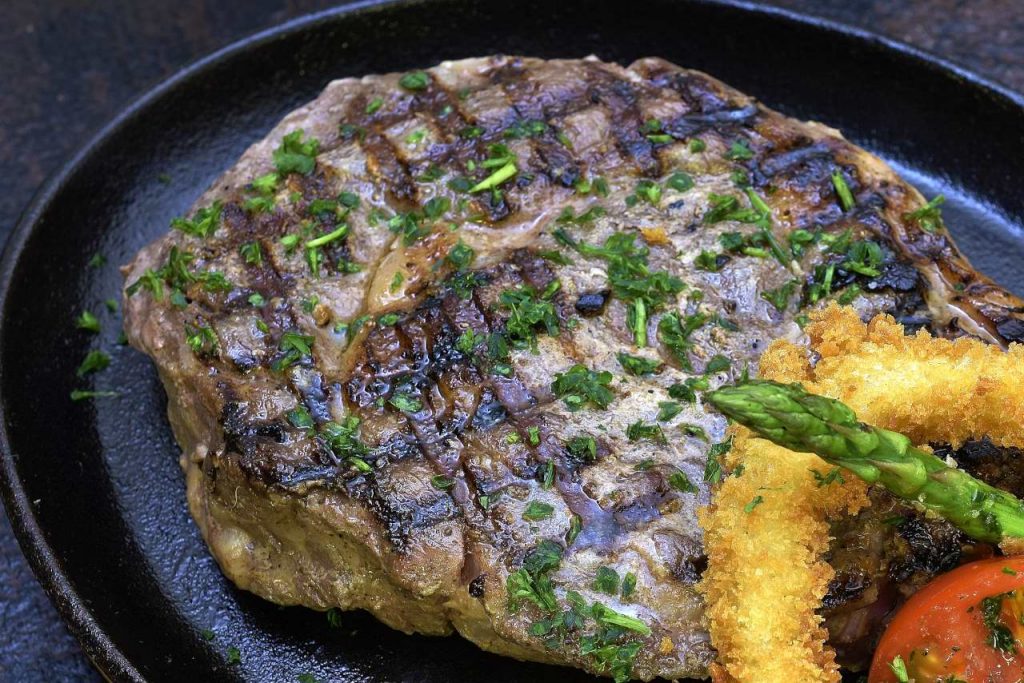
Did we learn anything?
Seasoning
Seasoning is another thing that people over-complicate. I rarely put anything in the bag because the science says that only salt can penetrate the surface of the protein. I ask myself “how much salt is the steak going to absorb during the time it takes to process?” Not much. Salt is used for curing meats, and at cool temperatures it penetrates no faster than 1″ every 3 days. The higher the heat, the more force is being created by the steak to EXPEL juices, not absorb them.
Some people want to season the steaks up to 24 hours in advance (or more) in order to give the salt time to penetrate the surface. Keep in mind that this practice initiates a chemical reaction that accompanies the curing process, and may alter the color, flavor, and texture of the steak. I prefer to apply a well thought out crust just before searing. The typical chef’s guideline is no more than 2 teaspoons of salt per 1 lb/450 g of meat. Ground black pepper to taste. Garlic powder tends to burn. I like fresh herbs, but they provide more appearance than flavor or even aroma.
For the best way to season sous vide processed meats, visit HERE.
Accompaniments
Just about everything goes with steak. Tomatoes. Potatoes. Any green vegetable.
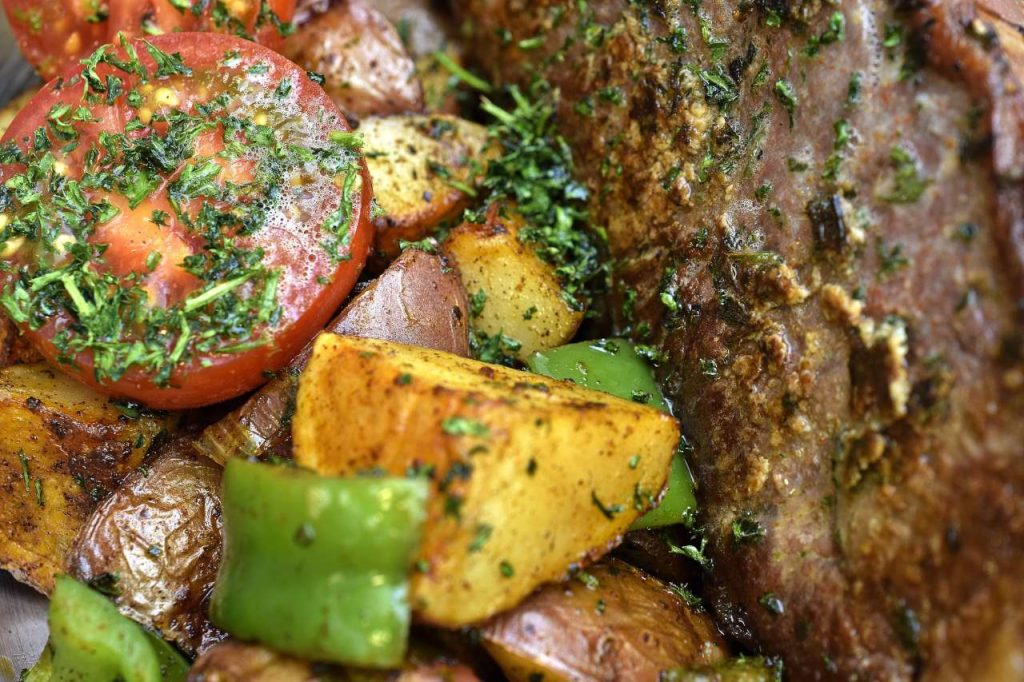
But I don’t just go to the store with a list. I try to keep certain things around, seasonally adjust, and think about color.
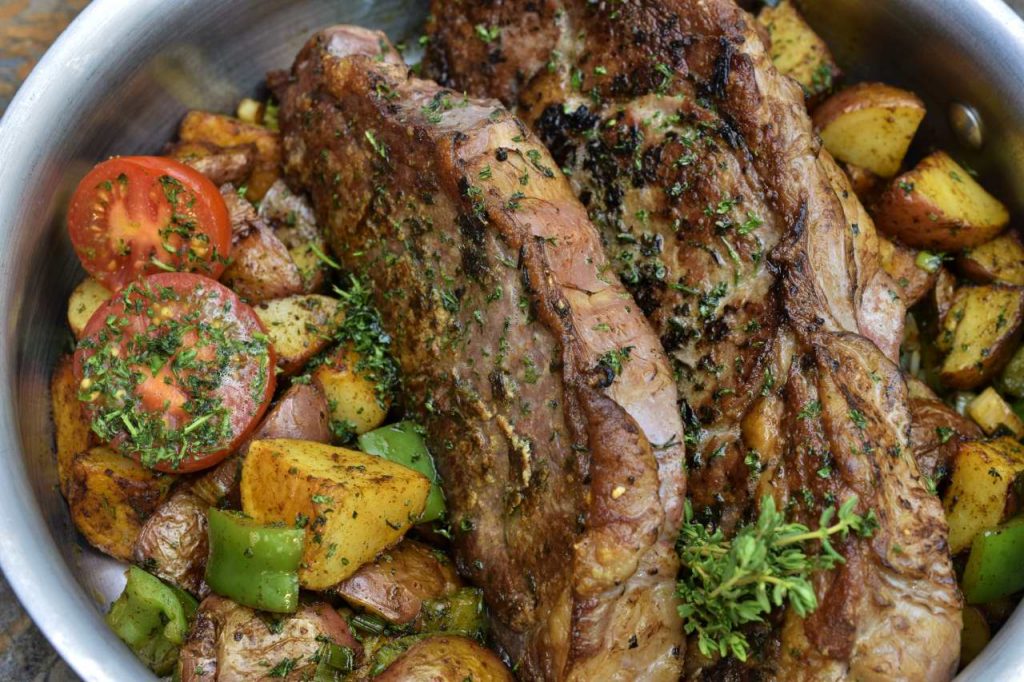
I almost never use blue, except for blueberry shortcake, muffins, pancakes, etc. Oregon has lots of blueberries.
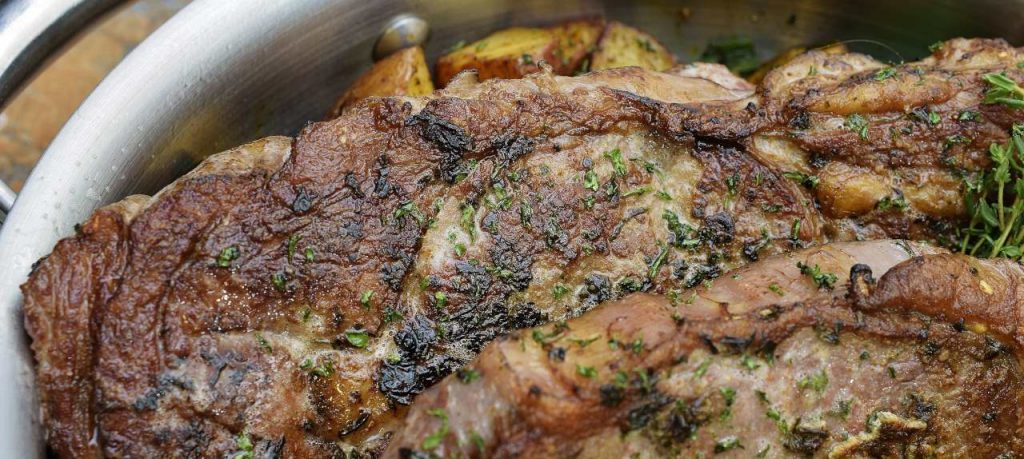
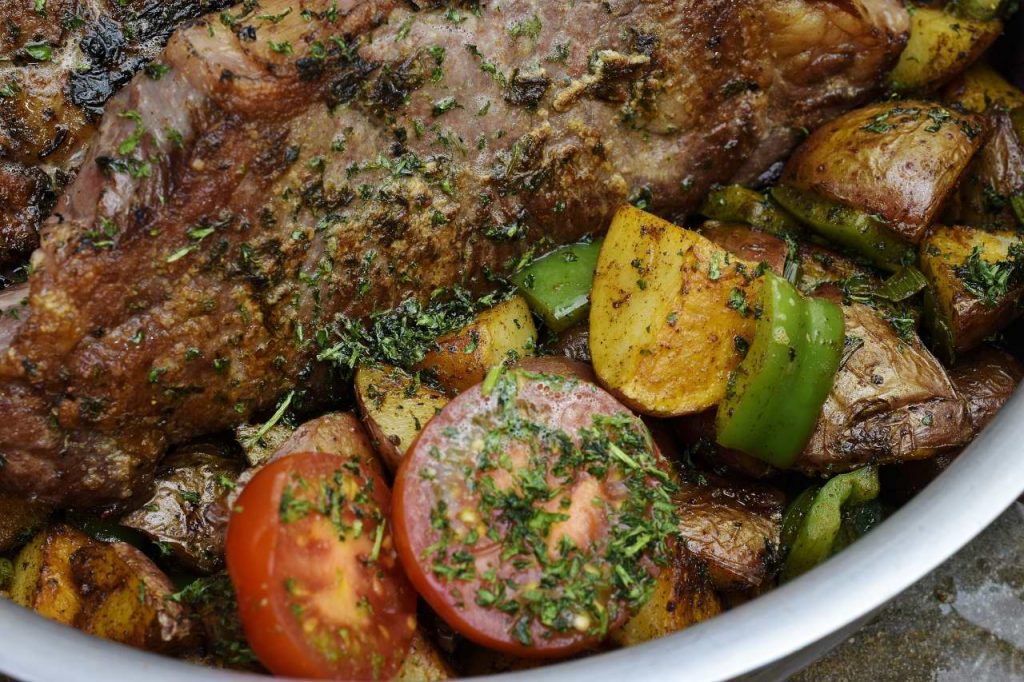
Searing
There is nothing like a steak. I shoot for 375 F/190 C+ on the surface of the pan. I do not oil the pan, I oil the steak. I might add another tablespoon of oil after putting the steak in the pan–this prevents the oil from burning. If you can tell what kind of oil you used to sear, you probably used too much. Finishing with butter is a good thing, but I never use it to sear; not even ghee. Since the steak is mouth hot coming out of the bath, it should never require more than a minute on each side to achieve a desirable crust.
